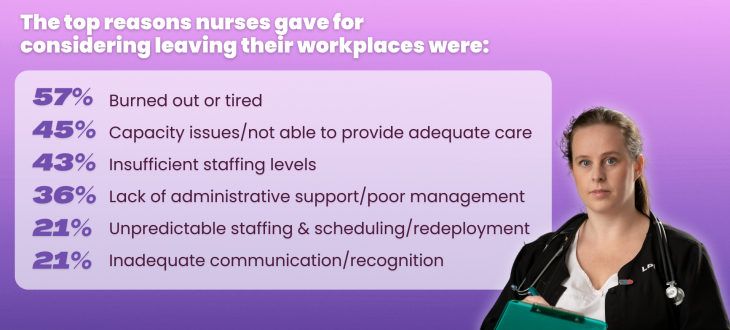By Jane Coutts for the Canadian Federation of Nurses Unions. (edited for this newsletter publication)
What are professionalism, compassion, dedication and personal sacrifice worth?
If you’re a registered nurse in Ontario, $5,000. That’s the amount the province’s government has promised nurses if they don’t quit their jobs between March 31 and September 1, 2022.
Certainly, suggests a lot of nurses are at risk of bailing from their jobs before summer’s over, doesn’t it? There’s a reason for that: Statistics Canada data show job vacancies for registered nurses and registered psychiatric nurses soared during the first 21 months of the COVID-19 pandemic, from 10,575 in the fourth quarter of 2019 to 22,955 at December 31, 2021 – an increase of 117 per cent. Job vacancies for licensed practical nurses also soared over those two years, growing by 190 per cent from 3,710 to 10,765, and nurse co-ordinator/supervisor vacancies increased from 420 to 595. Overall, there was a 133-per-cent increase in nursing vacancies.
In 2021, Quebec announced a program to keep people on the job but went further, offering nurses who had already quit or retired cash to come back. The size of the bonuses depends on which part of Quebec you work in – nurses in central or populous regions are entitled to $5,000 when the program starts and another $10,000 if they work full time for 12 months; their colleagues in more remote areas get $8,000 up front and then $10,000 for that year of full-time work.
In January 2022, when Omicron was surging, New Brunswick’s offer for luring retired critical care nurses back to work included a one-time payment of $1,000, an additional $1,000 premium per 37.5 hours worked, pro-rated plus expenses and even childcare expenses, if the nurse relocated.
Trouble is, none of those schemes or the others across the country are going to solve nursing’s problems, according to Linda Silas, president of the Canadian Federation of Nurses Unions (CFNU). The failure of what some are calling bribes to keep nurses on the job won’t go unnoticed by patients, Silas says.
What’s brought us to this point? Nursing researchers say it’s only partly due to the pandemic – that COVID‑19 exposed and exacerbated problems that have been around for decades.
A CFNU study done before the COVID‑19 pandemic began, Mental Disorder Symptoms Among Nurses in Canada, shows that the high-stress situations nurses regularly work in can be traumatic.
The three most frequent trauma exposures nurses reported were being physically assaulted (93 per cent), a death after extraordinary efforts were made to save the patient’s life (89 per cent), and the death of someone who reminded the nurse of a friend or family member (86 per cent). Twenty-three per cent of nurses screened positive for PTSD, 36 per cent for major depressive disorder, 26 per cent for generalized anxiety disorder, and 20 per cent for panic disorder. These rates of mental disorder symptoms were similar to those for public safety personnel, and much higher than for the general public.
The study also found that over their lifetimes, one third of nurses had thought of suicide, with 17 per cent planning for it and eight per cent attempting it.
With that level of trauma even before COVID‑19, many nurses were in too precarious a position to withstand the tidal wave of catastrophe it would bring to the world, their workplaces and even their homes.
Two out of three nurses surveyed by CFNU in late 2021 said their mental health is worse than it was one year prior, and 94 per cent were experiencing symptoms of burnout, with 45 per cent reporting severe burnout, up from 29% just prior to the pandemic. For many participants in that survey, leaving their jobs had become the only option: more than half – 53 per cent – were considering leaving their position within the next year. The total comprised 27 per cent who would look for a different nursing position, 19 per cent who wanted to leave the profession, and seven per cent thinking of retiring.
Thoughts of leaving were more common in early-career nurses (59 per cent vs. 56 per cent among mid‑career nurses and just 20 per cent of late-term nurses). Licensed practical nurses in the survey were more likely, at 52 per cent, to consider quitting than registered nurses.
The top reasons nurses gave for considering leaving their workplaces were:
- Burned out or tired, 57 per cent;
- Capacity issues and not being able to provide adequate care, 45 per cent;
- Insufficient staffing levels, 43 per cent;
- Lack of administrative support or poor management, 36 per cent wanted to escape;
- Unpredictable staffing and scheduling/redeployment, 21 per cent; and
- Inadequate communication/recognition, 21 per cent.
Maura MacPhee, a professor at the University of British Columbia, believes nurses are leaving the profession because they must rush to care for too many people at once and feel they are not able to give patients the care and help they entered nursing to provide. Over time, she said, nurses become emotionally exhausted and burned out. In turn, patients have also become distressed, and anger builds – sometimes to the point of violence. Nurses, unable or unwilling to take the stress, leave.
Sheri Price, a researcher and a professor of nursing at Dalhousie School of Nursing, agrees – she thinks nurses feel they have to choose between their patients’ health and well-being and their own.
“Every nurse I’ve ever interviewed has told me they entered the profession because they wanted to use their knowledge and skills to provide care and make a difference in patients’ lives,” she said in an interview.
Like many people, nurses often struggle to find mental health support, and burnout – and their depression and anxiety – can be worsened by the guilt of being the one who couldn’t keep going. The stigma attached to mental illness is as much of a problem in health care as in any other part of society, Price adds. “Nurses tell us that if they had a physical injury and were off sick, their colleagues would check in on them,” she said. “But when they have a mental health leave of absence…no one asks them how they’re doing.”
UBC’s Maura MacPhee described a list that’s used to measure what essential care has been missed because of heavy workloads, developed by a British nursing researcher Jane Ball. Ball’s research shows when nurses are overworked, they regularly leave essential work undone. That causes them emotional and moral distress. Another essential thing left undone is surveillance, where nurses are monitoring patients’ physical and emotional status. When nurses are rushed, they don’t often catch slow or subtle changes in patients – and patients can deteriorate and even die without proper nurse surveillance.”
When missed care chronically accumulates, nurses can’t take it anymore, and they leave, MacPhee says – resulting in other nurses facing heavier workloads and more patients at risk.
Those risks and the consequences of inadequate nursing have been well documented. A CFNU paper “Nurse Staffing: More for Less, Myth vs. Reality” notes that in acute care, lower levels of nurse staffing (and higher proportions of less-skilled care providers on staff) lead to increased mortality rates, more falls and infections, and longer hospital stays for patients. The numbers are remarkable: one U.S. study of more than 18 million hospital discharges found hospitals that increased the number of registered nurses and licensed practical nurses on staff had fewer incidents of patient harm and shorter stays by patients but did not increase costs.
So, increasing nursing care is good for nurses’ mental and emotional health and patients’ comfort and health. It reduces distress in both groups. How do we get there? Price says it’s time to stop searching for the perfect solution and bring in a combination of responses to deal with a multifaceted problem.
Every nurse should be given more opportunities to show leadership on the job, which could start with letting them organize how they do their work on any given shift. That should proceed to having nurses bring their knowledge and experience to the table when decisions are made that will shape care.
That should start with planning to avoid another disaster such as COVID brought to the health care system. The Canadian Institutes of Health Research has provided funding for a national study to look for ways to keep nurses on the job and reduce burnout, addressing the psycho-socio factors that have caused so much burnout among nurses. Their approach will be to ask nurses themselves what would help.
Improving health care teams, so nurses don’t feel they have to do everything themselves was a common theme in interviews. And more effort needs to go into training different types of health professionals to work as teams, starting early with interprofessional undergraduate education.
Canada’s steady progress to a crisis-level shortage of nurses (even without the pandemic) was predicted more than 20 years ago and has been faithfully tracked and studied since. What’s needed now, is to get health care policy makers and governments to act on the research evidence available.
Silas thinks the heart of the problem lies with governments that are well aware of the need for more nurses and for profound changes for all health care workers – but choose not to act on it. They know there’s evidence available showing how health care education should be reimagined, so teamwork is established from the beginning as the key to delivering high-quality care.
“We need to paint a picture of the future, because if we paint a picture of today, it would be a bleak one,” Silas said.

 Login Members Only
Login Members Only


